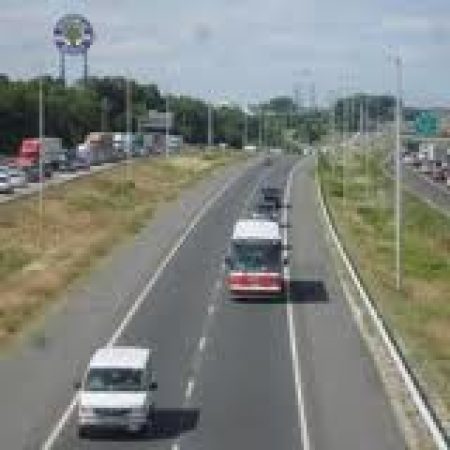 (This article first appeared in Reason Foundation’s Surface Transportation Innovations newsletter.) One of the most successful recent managed lanes projects is the one on I-95 in Miami, helped into existence by a federal Urban Partnership Agreement competitive grant award. The initial 7-mile segment, with two lanes each direction, has dramatically improved peak-period travel on the most-congested portion of I-95 in Florida. And the existence of reliably uncongested express lanes has led to very impressive growth in express bus ridership between Broward County (Fort Lauderdale area) and downtown Miami.
(This article first appeared in Reason Foundation’s Surface Transportation Innovations newsletter.) One of the most successful recent managed lanes projects is the one on I-95 in Miami, helped into existence by a federal Urban Partnership Agreement competitive grant award. The initial 7-mile segment, with two lanes each direction, has dramatically improved peak-period travel on the most-congested portion of I-95 in Florida. And the existence of reliably uncongested express lanes has led to very impressive growth in express bus ridership between Broward County (Fort Lauderdale area) and downtown Miami.
Phase 2, which will extend the project another 14 miles to downtown Fort Lauderdale, is now under construction. And the lanes are so popular that the maximum peak-period toll, which is now $7, is likely to be increased to $9 or more later this year.
Given that success story, I was taken aback by an article in the South Florida Sun-Sentinel early this year, sub-headlined “Fast lanes speed traffic, but do not cover their costs.” Over the next 10 years, wrote transportation reporter Michael Turnbell, FDOT expects annual losses to range from $971,000 to $3.5 million. The news story prompted a lead editorial in the paper a week later, headlined “Cut Express Toll Lane Costs.”
Based on my more than two decades of work on managed lanes, this story struck me as highly unlikely. I could imagine that a managed lane project in Minneapolis or Salt Lake City, say, might not relieve enough congestion to cover its costs out of toll revenues. But congestion on I-95 in Miami was nearly as bad as on the Los Angeles freeways, and the prices charged during peak periods are considerably higher than on many other managed lanes around the country. So I did some digging.
First, I asked FDOT for their figures on the I-95 Express Lanes revenues and expenses. They provided a 10-year spreadsheet, projecting data for fiscal years from 2012-13 to 2021-22. The “costs” part of the spreadsheet included not only operating & maintenance (O&M) costs but also (a) FDOT capital costs for phases 1 and 2, (b) a reserve fund/sinking account, and (c) transit operating subsidies. Including all those items did, indeed, show an operating loss in all but one of the 10 years.
My next step was to contact all the other managed lanes projects currently in operation around the country to ask how they define costs. I got replies from those involved with I-15 in San Diego, SR 167 in Seattle, I-25 in Denver, I-35W and I-394 in Minneapolis, I-10 in Houston, and I-85 in Atlanta. (I did not bother with SR 91 in Orange County, CA, since I already know they are covering both capital and operating costs out of toll revenues.) All reported that they cover their O&M costs from toll revenues, with some defining O&M a bit more broadly than others—and all report to the public that their managed lanes are self-supporting out of toll revenues. And MinnDOT expects to have recovered all capital costs on I-394 by 2014. None includes transit in their cost base.
When I adjusted the FDOT spreadsheet numbers to take out the transit subsidy, the 10-year total was a surplus of $27.3 million, even after covering capital costs. If the reserve fund (which none of the others have) is also omitted from the spreadsheet, the 10-year surplus is $67.3 million. In both cases, the Express Lanes would be in the black in every one of the 10 years, based on the criteria used by other state DOTs.
Dave Schumacher from SANDAG, which runs the I-15 lanes in San Diego, noted that “We provide funding to transit through excess revenue.” And that, in my view, represents a far more transparent approach to the toll-paying public than what FDOT is doing. Transit is not an “operating expense” of managed lanes; the transit services using the I-95 Express Lanes are not run by FDOT but by the Broward County and Miami-Dade County transit agencies. The proper accounting treatment is that transit subsidies are a use of surplus revenue.
There is also a longer-term issue at stake here. FDOT, like many other state DOTs responsible for expressway systems in major urban areas, is planning to develop an extensive network of managed lanes, most of which will involve new construction. Nearly all the currently operational managed lanes projects have been developed primarily or entirely by converting existing HOV lanes, meaning their capital costs were modest. Thus, the cost per lane-mile of a managed lanes network will be far higher than the cost per lane-mile of first-generation HOV conversion projects. To condition the public to believe that managed lanes generate significant surplus revenue for transit subsidies is foolish, since for the networks actually planned that will not happen.
It would be helpful for the growth and acceptance of managed lanes if state DOTs would agree on a common definition of the capital and operating costs of such projects. That way, apples versus apples comparisons could be made among projects, enabling researchers and policymakers to get a better handle on managed lanes economics.

Email this author






